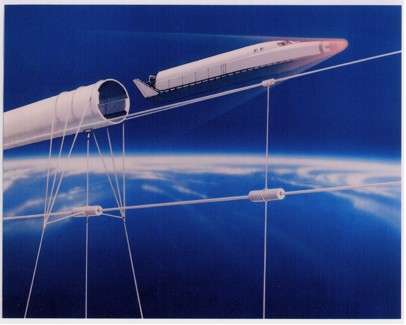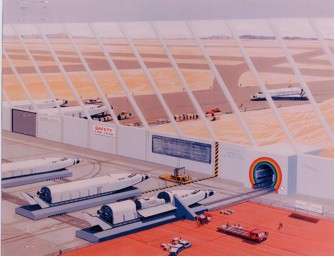March 13, 2012 report
Maglev track could launch spacecraft into orbit

(PhysOrg.com) -- With the aim to make it easier to launch spacecraft into low Earth orbit (LEO), two researchers have turned to maglev technology to catapult a payload hundreds of miles above the Earth. While the concept may sound far-fetched, the researchers argue that the potential benefits to humanity far outweigh the costs.
The proposed launch system, called Startram, doesn't use rockets or rocket fuel, but instead is based on the concept of a mass driver. Also known as an electromagnetic catapult, a mass driver acts like a coilgun to magnetically accelerate a magnetized holder containing a payload. Although mass drivers commonly appear in science fiction and a few other concepts have been proposed, none has yet been built.
But according to its designers, Startram uses available technology and is commercially feasible, suggesting that it could potentially be built. The developers, Dr. James Powell, who co-invented superconducting maglev trains, and Dr. George Maise, an aerospace engineer who previously worked at Brookhaven National Laboratories, have as much experience as anyone to push the idea forward.

The researchers have proposed two different models: a cargo-only version (Generation 1), which would cost about $20 billion and take about 10 years to build, and a passenger version (Generation 2), which would cost about $60 billion and would need about 20 years for completion. While the cargo-only version could be built up the side of a tall mountain without the need for levitated tubes, the passenger version would require levitated tubes to hold the track up.
According to their plans, the Generation 2 magnetically levitated track would run about 1,609 km (1,000 miles) long, heading upward to an altitude of about 20 km (12 miles). While the track would be securely tethered to the ground, it would be held in mid-air completely by magnetic levitation. The entire track would be enveloped in a vented vacuum tunnel to avoid sonic shock waves that result from the spacecraft's hypersonic speeds of up to 9 km/sec (5.6 miles/sec). Once it exits this track, the spacecraft would be in position to reach LEO.

While it's easy to imagine what might go wrong with such a scheme, the researchers say the levitation force is more than strong enough for this purpose. They argue that Startram's cost advantages compel serious consideration. Currently, launching 1 kg (2.2 lb) of payload into LEO by rocket costs about $10,000. The researchers estimate that StarTram could do the same for just $50. For space travelers, Startram could decrease the cost from $20 million (the current cost of sending a person to the International Space Station) to about $5,000.
As the developers explain, building such a system is within reach of current technology, with the biggest challenge being one of scale. Even though the velocities for the system would need to be about 50 times faster than today's maglev trains (which travel at speeds of up to 600 km/hr [373 mph]), much of the engineering is the same. Also, researchers at Sandia National Laboratories have performed an initial “murder-squad” investigation of the concept and found no obvious flaws.
On their website, Powell and Maise cite many reasons why having a Startram launch system would be useful: defending the Earth against large asteroids, harvesting solar energy, mining raw materials from asteroids and comets, building space-based industries, and space colonization.
More information:
www.Startram.com
via: Gizmag
© 2011 PhysOrg.com



















